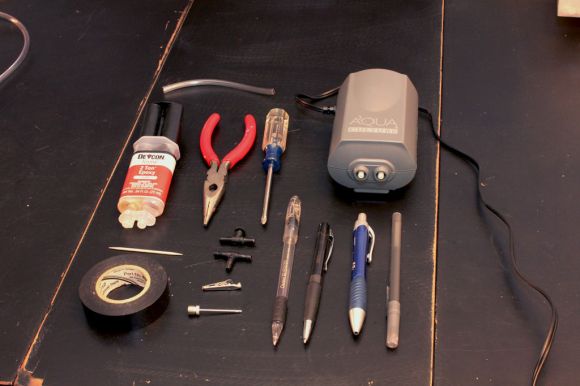
Everything you need to build a vacuum tweezers is laid out in this image. The parts should run you about $20 and when you’re done you’ll have the perfect tool for placing very small surface mount parts for reflow soldering.
This project uses the same concept as other fish pump tweezers projects but builds upon them with some interesting additions. The first step in the conversion process is to tear down the aquarium pump to reverse its flow. There are several steps but all-in-all it’s not very difficult. With the source of vacuum established [Technically Artistic] begins work on the business end of the tool. This is where the array of different pens see some action. The large blue one is the outer assembly, with the others combining to help connect it to the plastic tubing. The business end is made from a needle adapter for an air compressor, with an alligator clip cleverly modified to serve as a valve to release the parts from the tip.
















I did quite a bit of work on reusing aquarium pumps as vacuum pumps a few years back, and this may save some people a little labor if they build one. These have a vacuum port as well as a pressure port. No modification is required.
http://www.amazon.com/Tom-Aquatics-Aqua-Lifter-Dosing-Pump/dp/B001EUI390/ref=sr_1_2?ie=UTF8&qid=1359133947&sr=8-2&keywords=dosing+pump
Why not make an aspirator type pump powered by compressed air, or from a water tap?
Get a pipe T, a short length of pipe to match, some polymorph, and an old biro. Chose the pipe T so its threads match that of the fittings on the end shower hose(or air hose). Carefully cut the biro in to three pieces. Should end up with two short pieces of reducing diameter, and one long piece. The piece with smallest hole forms a nozzle and the wider but still tapering piece will form a collecting “cone”. Use polymorph to form two plugs the fit inside the pipe T. one plug contains the nozzle, and the other the cone. The plugs need to seal against the sides of the pipe, with a fairly small gap between the plugs Connect a short length of pipe to the cone side as a basic diffuser. Connect the shower hose between “tap” and the side of the T which contains the nozzle, if things are properly aligned water should be jet out of the nozzle, and exit straight through the cone/diffuser- That entraps a surprising amount of air, and can generate a vacuum. Place your thumb over the end of the branching T when the water’s on, and you should notice that vacuum. For more vacuum play around with the gap between nozzle and cone, and perhaps try different sizes/combinations of nozzle and cone. That’s what makes polymorph is so useful here, it allows adjustment/tweaking. Connect a 2nd shower hose to the branch of the T. If diameter of silicone tubing has been carefully chosen it should be possible to jam it in the end of the pipe T NB flowing hot water through the silicone tube makes it far more flexible.
There ain’t that much volume inside small diameter silicone tubing, so even with a long length, it wont take long for vacuum to be pulled at the end of it
They make too much noise.
I made one using that exact pump, and found it inadequate for lifting most electronic components. However, I didn’t use a T fitting for both sides of the pump…they’re independent so I figured wouldn’t matter. But double the suction might make it useful.
I’m the one that made it and yeah there’s a big difference between one and two valves being used. Also, I just found out that you can do the same with a Whisper 100, which I just happened to have, which is rated for up to 100 gallons and is stronger. Not a lot stronger mind you but I can at least hear the difference in suction, though I don’t have a way to measure it accurately. But I linked the other instructable explaining how to reverse that pump. Whisper also makes some stronger pumps for ponds and larger tanks, but I don’t know what those look like inside. I don’t have the T-Valves for it at the moment, but I’m wondering how much better it would do if I had both pumps running at once to the pen.
Just put a blob of blu-tack on a pencil eraser and use it to pick up your SMT chip and place it. When the chip is in-place, hold it down with your tweezers and pull the blu-tack off. No noisy vacuum pump to break down.
Great post! I was inspired to finally build one of my own today. I used a Whisper 10 and found that it worked just fine for picking up any small parts which were my target. Thanks for the inspiration!
http://ianlee.info/2013/01/smd-manual-part-picker.html
Great job!! i am just inspiring by read your post and its quiet helpful to build the pen vacuum.Using a aquarium pump its working very well to build it.
Very interesting and cheap – just a hint about plastic tubing – it is usually very soft and sensitive to heat. Also, 3 feet is not enough if you need free space on your work bench – since it is cheap, 5 feet of tubing is nice for keeping pump away ….
This can be improvised using small, used vacuum cleaner, since they are very cheap.